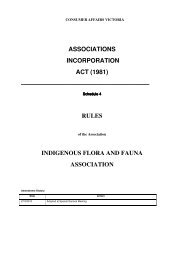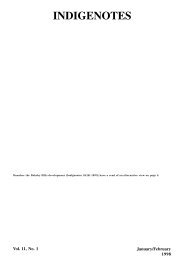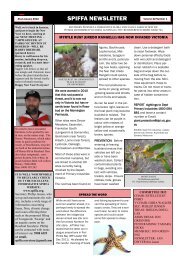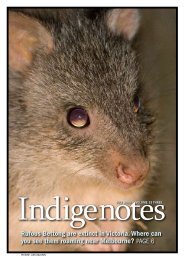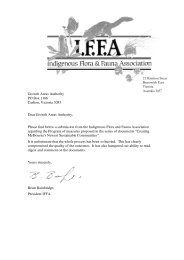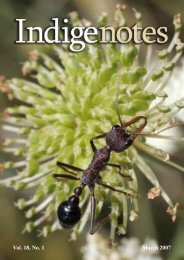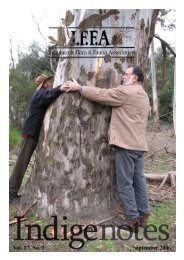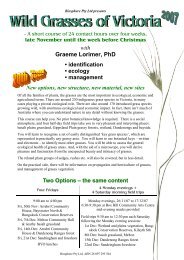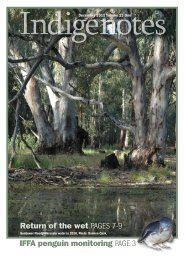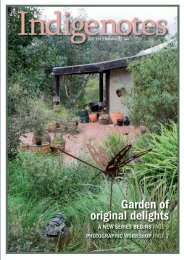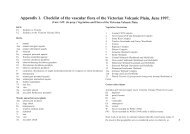July 2009 Volume 20 Two - Indigenous Flora and Fauna Association
July 2009 Volume 20 Two - Indigenous Flora and Fauna Association
July 2009 Volume 20 Two - Indigenous Flora and Fauna Association
Create successful ePaper yourself
Turn your PDF publications into a flip-book with our unique Google optimized e-Paper software.
One day under Flinders jetty<br />
It was the last day in Australia for Rhonda, an exchange ranger from Canada, <strong>and</strong> the<br />
plan was to see one of Victoria’s state emblems — the Weedy Seadragon<br />
The late April weather wasn’t promising — a blustery<br />
day with ragged clouds running across the sky. However, the<br />
wind was from the north <strong>and</strong> Flinders jetty, a known lurking<br />
spot of these Southern Australian marine creatures, would be<br />
relatively sheltered.<br />
We agreed to all meet at Flinders jetty, on the Western Port<br />
Bay side of the Mornington Peninsula, having seen Weedy<br />
Seadragons there previously (both by snorkelling – a lucky<br />
chance, I think – <strong>and</strong> using scuba gear). After a leisurely cup<br />
of hot chocolate <strong>and</strong> with one eye on the weather, we geared<br />
up <strong>and</strong> started down the jetty.<br />
The water was surprisingly clear <strong>and</strong> calm, <strong>and</strong> the marine<br />
life covering the pier legs extraordinary in its variety of shapes,<br />
colours <strong>and</strong> sizes. Ascidians <strong>and</strong> sponges in a dazzling array.<br />
The more we looked, the more we saw. Unfortunately, I<br />
couldn’t begin to put names to these – in the end, I could<br />
only play “art appreciation” not “marine biologist”.<br />
As we moved further towards the end of the jetty, we<br />
started to see our quarry.<br />
These dainty, timid creatures swim slowly <strong>and</strong> gracefully,<br />
<strong>and</strong> are surprisingly difficult to photograph. They much<br />
prefer to face the camera, keeping an eye on possible danger,<br />
rather than turning sideways where their amazing colour<br />
pattern of orange-red background, bright blue stripes <strong>and</strong><br />
many white spots <strong>and</strong> yellow markings can be admired. Tiny<br />
fins are found on either side of their head for balance <strong>and</strong><br />
a long shimmering dorsal fin along their back propels their<br />
body through the water. They are not strong swimmers <strong>and</strong><br />
are often found washed ashore after storms. However, they<br />
do have a surprising turn of speed just when you have them<br />
perfectly framed to photograph!<br />
Long leaf-shaped flaps of skin protrude from stalk-like<br />
bony projections at intervals along the top <strong>and</strong> bottom of<br />
IFFA EVENT<br />
Global Financial Crisis? No, Global Environmental Crisis!<br />
Presented by Dr Roger N Jones. 2pm Sunday 30th August<br />
Climate is changing faster than anticipated, <strong>and</strong><br />
even if the world manages to reach a peak in<br />
emissions <strong>and</strong> global population around <strong>20</strong>50,<br />
the world is likely to have a population of about<br />
9 billion <strong>and</strong> be 2°C warmer than pre-industrial<br />
temperatures.<br />
In Victoria since 1996, climate has already reached levels<br />
of change that were projected for <strong>20</strong>30-<strong>20</strong>50. Ecosystems<br />
are responding to that change — wetl<strong>and</strong>s <strong>and</strong> floodplain<br />
ecosystems are under severe stress, tree dieback is<br />
widespread in grassy ecosystems <strong>and</strong> woodl<strong>and</strong> <strong>and</strong> wetl<strong>and</strong><br />
birds are in decline. We are facing a global ecological<br />
crisis. The world’s ecosystems underpin everything: our<br />
economy, human livelihoods <strong>and</strong> environmental security.<br />
This is green infrastructure. If we look at the current<br />
investment in this infrastructure, it is being allowed to<br />
decline to well below sustainable levels. However, by better<br />
the body, <strong>and</strong> as well as looking like seaweed, their similar<br />
swaying motion as seaweed in the water current makes them<br />
difficult to spot.<br />
Luckily, Flinders jetty is something of a haven for them<br />
<strong>and</strong>, particularly in winter <strong>and</strong> in their spring breeding time,<br />
large numbers gather in the shelter provided by the pier.<br />
The males (like sea horses) carry the eggs for up to 2 months<br />
before the baby seadragons hatch as miniature versions of the<br />
adults, just 2.5 centimetres long.<br />
Weedy seadragons can grow up to 46cm long <strong>and</strong> live for<br />
up to 10 years. They eat plankton, sea lice, larval fishes <strong>and</strong><br />
small shrimp-like crustaceans called mysids.<br />
Along with pipe fish <strong>and</strong> seahorses (which can also be<br />
found at Flinders jetty – although we didn’t see any today),<br />
they are members of the Syngnathidae family. They are<br />
found only along the coast line of southern Australia usually<br />
in shallow water (up to 50m deep) mainly inhabiting kelp<br />
forests, reef edges, seagrass meadows <strong>and</strong> seaweed beds.<br />
We saw our ones in 2 metres of water in the seaweed bed<br />
alongside the jetty.<br />
The Weedy Seadragon was selected as Victoria’s official<br />
marine faunal emblem by public nomination in <strong>20</strong>02, <strong>and</strong> is<br />
fully protected under the Victorian Fisheries Act 1995.<br />
The aim of the day was met, with Rhonda’s experience<br />
of Victorian flora <strong>and</strong> fauna rounded out with the intricate,<br />
beautiful marine life on our rocky shores.<br />
The Canadian ranger saw her Weedy Seadragons,<br />
Phyllopteryx taeniolatus, <strong>and</strong> Parks Victoria ranger Jono<br />
Stevenson filled in the marine biology side for us all.<br />
Jo James<br />
OVERLEAF: A beautiful pictorial record of the day<br />
underst<strong>and</strong>ing ecological processes <strong>and</strong> how they maintain<br />
this infrastructure, we can learn how to build resilience into<br />
adaptation planning. It is time that departments of finance<br />
<strong>and</strong> treasury became interested in green infrastructure. We<br />
need a business plan for ecosystems.<br />
Dr Roger N Jones, previously with CSIRO, is now Professorial<br />
Research Fellow of the Centre for Strategic Economic Studies,<br />
Victoria University.<br />
2pm Sunday 30th August at Victoria University City Campus,<br />
300 Flinders Street Melbourne (opposite Flinders Street<br />
Station) 11th floor room 1101.<br />
Don’t forget you can buy a Sunday Saver Metcard for $3.10<br />
that will get you there <strong>and</strong> back again on public transport<br />
from anywhere in Melbourne.<br />
All welcome. Enquiries to Michele Arundell,<br />
phone (03) 9755 3347 or email michelearundell@yahoo.com<br />
INDIGENOTES VOLUME <strong>20</strong> NUMBER 2 5



